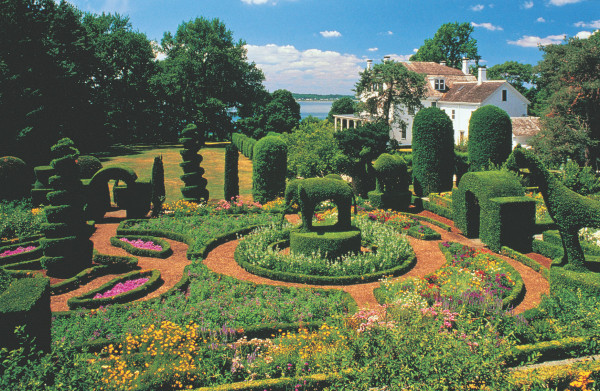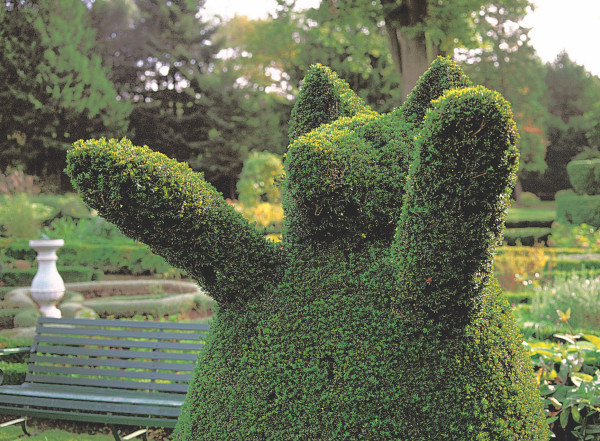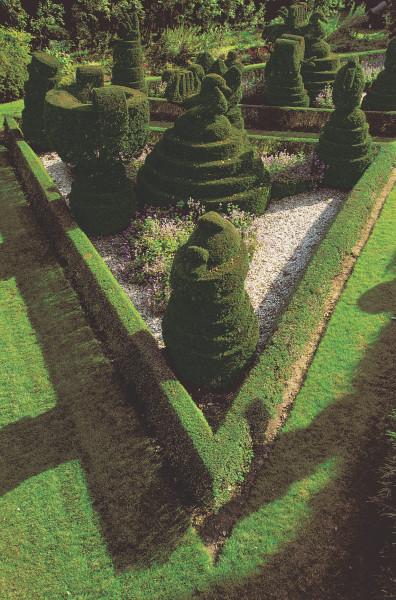
Courtesy Preservation Society of Newport County
The Maine bungalow garden is populated with sculptural plantings: giant hostas, climbing roses, and spiral topiary arborvitae. Topiary has a long history and, like many decorative effects, it becomes fantastical when taken to extremes.
Topiary is the art of training, coaxing, shearing, and clipping plants into verdant sculpture, abstract or representational. It’s not just limited to living statues, but also encompasses trained hedges, mazes, knot gardens, and espaliers—plants trained to grow flat against a wall. The practice may go back to Julius Caesar’s gardener in the first century B.C.
At Green Animals, the cuddly bear’s friends include an elephant, a giraffe, camel, donkey, three peacocks, a swan, an ostrich, a reindeer, three dogs, and a hen. Ken Druse
During the Renaissance, Italian pleasure gardens were adorned with ornate hedges and shrubs clipped into cones and balls, ships and animals. In Elizabethan England, lavender, rosemary, thyme, and santolina were used to organize medicinal and culinary herbs into a form of flat topiary known as the knot garden. The Dutch have embraced topiary for 500 years. Unlike the French and Italians, the Dutch create small outdoor rooms filled with an array of animal shapes and “green furniture.”
During the 18th century, the “natural” garden was favored over the tight and formal landscapes where topiary had reigned. But the idea survived as a sort of folk art by English cottage gardeners until the Victorians re-introduced topiary and formal carpet bedding. Topiary appeared in Williamsburg, Virginia, around 1690. The heyday of American topiary coincided with the golden age of American gardening during the end of the 19th century and the early decades of the 20th. Some gardens begun then are maintained and open to the public today.

Robert Noonan
Public Topiary Gardens
GREEN ANIMALS TOPIARY GARDEN, PORTSMOUTH, RHODE ISLAND
At a historic estate on Narragansett Bay, more than 80 topiaries include animals and birds, plus geometric figures and ornamental designs sculpted from California privet, yew, and English boxwood. Green Animals Topiary Garden is the oldest and most northern topiary garden in the U.S. newportmansions.org
LADEW TOPIARY GARDENS, MONKTON, MARYLAND
On a par with Green Animals, this 22-acre garden full of “plant statues” was started before 1929. There’s also a nature walk and butterfly house. ladewgardens.com
LONGWOOD GARDENS, KENNET SQUARE, PENN.
Indoor and outdoor gardens, geometric yews nearly a hundred years old, topiary birds, rabbits, table and chair, espaliered fruit trees, and a conservatory. Some of the 50 different specimens were planted in 1936; most came from a Long Island estate in 1958. longwoodgardens.org
MAGNOLIA PLANTATION, CHARLESTON, S.C.
An ongoing, unrestored Romantic estate dating from the 17th century, with topiary zoo, a camellia maze, and a biblical garden. magnoliaplantation.com
FILOLI, WOODSIDE, CALIF.
The National Trust property 25 miles south of San Francisco boasts knot gardens, clipped yews, and the Chartres Cathedral Window made up of annuals; 2017 is the Garden year in the property’s centennial celebration. filoli.org
DISNEYLAND, ANAHEIM, CALIF.
In the park are 26 topiaries dating to 1963, including Dumbo. And Epcot at Walt Disney World in Orlando, Florida, has 100 topiaries depicting Disney characters. disneyparks.disney.go.com







